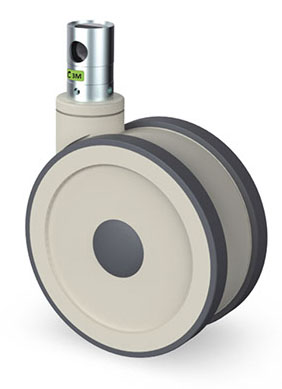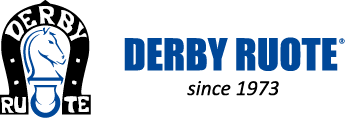 Wheel’s and relevant housing’s choice should be made according to the use conditions which in their turn are determined by different factors.
Wheel’s and relevant housing’s choice should be made according to the use conditions which in their turn are determined by different factors.
A skilled technical analysis is thus composed of a precise path to take which enables to correctly individuate the product to be used according to the needs to satisfy.
In the following concise guideline some short descriptions could simplify the evaluation and the best solution research for any need.
● Typology of the sliding plane The first element to consider is with no doubt the nature of the surface which the wheel will roll upon.
A practical and simple rule permits to fix a binomial which is usually valid for most of applications: a hard surface rolling plane corresponds to a relatively soft wheel’s tread and vice versa. In a broad sense, such a rule is to be considered valid also in presence of obstacles and/or unevenness which could slightly compromise the correct work ing of the idea l motion conditions, with a consequent overall mechanical efficiency reduction of the wheel/housing system. This catalogue, in order to satisfy any working condition, offers a wide range of castors, designed with different materials and wheels’ mixtures.
●Working environment conditions Behind the general definition of “working environment conditions” many physical, chemical and climatic variables are hidden (e.g. temperature, humidity, irradiation, presence of acids and bases, steams, salt sprays, waters, hydrocarbons presence…) and which could influence in a determinant way the final castor’s choice.
The different combinations among housings and wheels, the extremely high quality of the raw materials and chemical additives, finishing levels and surface coats of high impact (both technical and aesthetical) could surely satisfy any working environment condition also in presence of very aggressive agents which could namely affect metallic and polymeric materials.
● Top working load capacity and necessary dynamic load capacity
The notions of “top working load capacity” and “necessary dynamic load capacity” are extremely important and must be carefully evaluated in order to obtain all the assurance for an efficient wheel motion.
The top working load is determined not only by the summation of the tare and the net weight of the object to move, identifying the static load, but it must consider also that at any time the dynamic conditions could change. In fact, as it’s well known, a geometrical plane is univocally determined by three undefined points in space.
Due to the manufacturing exigencies of the object to move, to the ineluctable imperfection of the rolling surface and to the influence of the nature of the load itself, the real working condition always differs from the ideal one and, realistically, the contact points to the rolling surface are always less than the theoretical ones.
This is, briefly speaking, the real working dynamic condition; a good and skilled project’s choice should take all that into consideration. Generally speaking, the good sense suggests to consider the load of every castor as the ratio of the static load non related to the real number of “n” castors but to the (n-1) in case of solid load and to the (n-2) in case of liquid load.
● Rolling and swiveling resistance
The force which generally is defined as a loss of mechanical energy due to the deformation of the contact area is known as rolling resistance and would not exist in case of friction’s absence and in case if the rolling surface is perfectly ideal and non deformable.
But in real conditions, the rolling resistance depends on many structural factors such as the geometrics of the wheel’s tread but, first of all, on the viscous-elastic properties of the elastomers’ and polymers’ mixtures used for the manufacturing of the wheel’s tread.
Our great experience, as a result of years and years of accurate research gave the result ofobtaining wheels whose features permit to minimize the performance losses, due to the inevitable rolling resistance.
The swiveling resistance is defined as the force to apply so that the castor’s swiveling is done around the perpendicular axle of the working surface.
The swiveling should be possible in any working condition thus either in the static and/or in the dynamic position.
The factors ensuring a better handling are manifold and could identified in the stress type, in the diameter of the wheel, in the nature of the tread, in the type and size of the balls bearings used for the axial loads upholding.
The great accuracy and the choice of using safety coefficients high values can grant an overall efficiency of our castors, being the cutting edge of our manufacturing.
● Coloration due to contact
In particular environments, it is very important that at the end of the passage of the system to be moved there’ll be no trace of its passage upon the rolling surface.
The tread’s hardness and configuration are thus extremely important and an accurate choice can avoid the onset of unpleasant episodes namely the coloration due to contact.
In this catalogue, the user could individuate the best technical solutions so that any specific exigency could be satisfied.
● Cleaning and washability
As an end users market’s need, it is lately spotlit that the exigency of regular cleaning and washing operations are needed, as indicated in the end user’s specifications.
The range of wheels and castors listed in this catalogue are designed for satisfying such needs, even in their project phases, and are also more and more appreciated in the hospital and food industry domain.
Our wheels and castors are designed so that the ordinary cleaning could be easily done and in a total safety.
The resistance is granted against all aggressive cleaning agents (whose origin is synthetic, animal and vegetal) normally used in the medical environments.
Besides, it is also possible to operate cleaning either manually and/or automatically, in respect to the permitted maximum washing liquid temperature and to the average foam tenor obtained from detergent and detersive solutions.
● Antistaticness and electric conductivity
The friction between two materials having different nature, also in normal using conditions, can generate an accumulation of strong electrostatic charges.
When an operator touches an object put on the ground, the discharge could generate a spark which, in presence of inflammable powders or sprays, could be enough to generate an explosion. Most of polymers, among whom many commonly used plastic material stake place, are bad conductors and are incline to electrostatically charge during their use.
In order to curb the accumulation of electrostatic charges, the materials used by Derby Ruote for such applications are mixed with specific additives which attract the air humidity on the surface of the polymer thus improving the surface conductivity and practically nullifying the risk of electrical discharge.
Derby Ruote, who is producing polymeric materials castors even classified as electric conductive, can provide a definitive solution, with values of electrical resistance below the international requirements (with a difference applied potential value of 500 V: R ≤ 105 Ω for electric conductive castors and 105 Ω ≤ R ≤107 Ω for antistatic castors).
● Final considerations
From the above concise general considerations, it can be inferred that the variables for an ideal choice of the castor for indoor motion are manifold and, sometimes, in contrast.
The aim of what above is to try and identify all the manufacturing typologies available for the user. But the most important perquisite of the Company philosophy, adopted by Derby Ruote, is to stand next to our customers during any phase of the project of selection of what is best for them and of choosing the most suitable product for their needs.
For such a reason, all the Company’s divisions, starting from the top management, through the sales dpt. ending with the technical dpt. are at full customers’ disposal; in case of need, please do not hesitate to contact us so that the we could reach what we first put at the top of our targets’ chart: the customer’s satisfaction.


